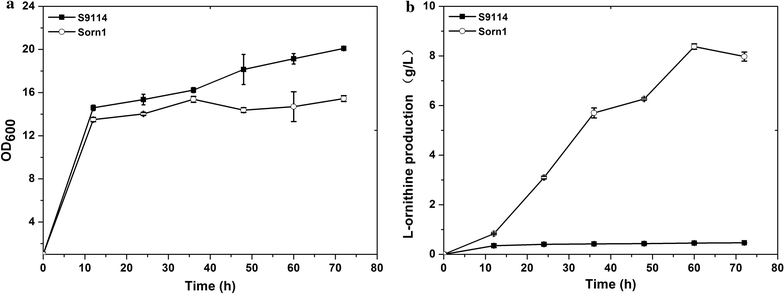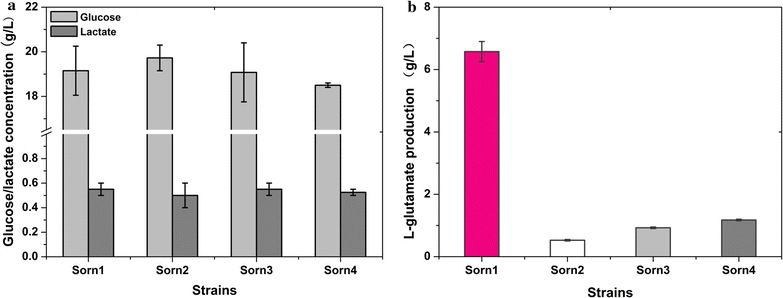Systematic pathway engineering of Corynebacterium glutamicum S9114 for L-ornithine production
- PMID: 28938890
- PMCID: PMC5610420
- DOI: 10.1186/s12934-017-0776-8
Systematic pathway engineering of Corynebacterium glutamicum S9114 for L-ornithine production
Abstract
Background: L-Ornithine is a non-protein amino acid with extensive applications in medicine and the food industry. Currently, L-ornithine production is based on microbial fermentation, and few microbes are used for producing L-ornithine owing to unsatisfactory production titer.
Results: In this study, Corynebacterium glutamicum S9114, a high glutamate-producing strain, was developed for L-ornithine production by pathway engineering. First, argF was deleted to block L-ornithine to citrulline conversion. To improve L-ornithine production, ncgl1221 encoding glutamate transporter, argR encoding arginine repressor, and putP encoding proline transporter were disrupted. This base strain was further engineered by attenuating oxoglutarate dehydrogenase to increase L-ornithine production. Plasmid-based overexpression of argCJBD operon and lysine/arginine transport protein LysE was tested to strengthen L-ornithine synthesis and transportation. This resulted in efficient L-ornithine production at a titer of 18.4 g/L.
Conclusion: These results demonstrate the potential of Corynebacterium glutamicum S9114 for efficient L-ornithine production and provide new targets for strain development.
Keywords: Corynebacterium glutamicum; L-Ornithine production; Metabolic engineering.
Figures






Similar articles
-
Metabolic engineering of Corynebacterium glutamicum for the production of L-ornithine.Biotechnol Bioeng. 2015 Feb;112(2):416-21. doi: 10.1002/bit.25440. Epub 2014 Sep 29. Biotechnol Bioeng. 2015. PMID: 25163446
-
Enhanced l-ornithine production by systematic manipulation of l-ornithine metabolism in engineered Corynebacterium glutamicum S9114.Bioresour Technol. 2018 Feb;250:60-68. doi: 10.1016/j.biortech.2017.11.017. Epub 2017 Nov 8. Bioresour Technol. 2018. PMID: 29153651
-
Metabolic engineering of Corynebacterium glutamicum S9114 to enhance the production of l-ornithine driven by glucose and xylose.Bioresour Technol. 2019 Jul;284:204-213. doi: 10.1016/j.biortech.2019.03.122. Epub 2019 Mar 25. Bioresour Technol. 2019. PMID: 30939382
-
Strategy for improving L-isoleucine production efficiency in Corynebacterium glutamicum.Appl Microbiol Biotechnol. 2019 Mar;103(5):2101-2111. doi: 10.1007/s00253-019-09632-2. Epub 2019 Jan 20. Appl Microbiol Biotechnol. 2019. PMID: 30663007 Review.
-
Updates on industrial production of amino acids using Corynebacterium glutamicum.World J Microbiol Biotechnol. 2016 Jun;32(6):105. doi: 10.1007/s11274-016-2060-1. Epub 2016 Apr 27. World J Microbiol Biotechnol. 2016. PMID: 27116971 Review.
Cited by
-
Development of a DNA double-strand break-free base editing tool in Corynebacterium glutamicum for genome editing and metabolic engineering.Metab Eng Commun. 2020 Jun 1;11:e00135. doi: 10.1016/j.mec.2020.e00135. eCollection 2020 Dec. Metab Eng Commun. 2020. PMID: 32577397 Free PMC article.
-
Production of l-glutamate family amino acids in Corynebacterium glutamicum: Physiological mechanism, genetic modulation, and prospects.Synth Syst Biotechnol. 2021 Sep 20;6(4):302-325. doi: 10.1016/j.synbio.2021.09.005. eCollection 2021 Dec. Synth Syst Biotechnol. 2021. PMID: 34632124 Free PMC article. Review.
-
Improved L-ornithine production in Corynebacterium crenatum by introducing an artificial linear transacetylation pathway.J Ind Microbiol Biotechnol. 2018 Jun;45(6):393-404. doi: 10.1007/s10295-018-2037-1. Epub 2018 May 4. J Ind Microbiol Biotechnol. 2018. PMID: 29728854
-
Improvement of L-ornithine production by attenuation of argF in engineered Corynebacterium glutamicum S9114.AMB Express. 2018 Feb 24;8(1):26. doi: 10.1186/s13568-018-0557-8. AMB Express. 2018. PMID: 29478233 Free PMC article.
-
Recent Advances of L-ornithine Biosynthesis in Metabolically Engineered Corynebacterium glutamicum.Front Bioeng Biotechnol. 2020 Jan 9;7:440. doi: 10.3389/fbioe.2019.00440. eCollection 2019. Front Bioeng Biotechnol. 2020. PMID: 31998705 Free PMC article. Review.
References
-
- Lee J-H, Wendisch VF. Production of amino acids-Genetic and metabolic engineering approaches. Bioresourc Technol. 2017 - PubMed
-
- Jorge JM, Pérez-García F, Wendisch VF. A new metabolic route for the fermentative production of 5-aminovalerate from glucose and alternative carbon sources. Bioresourc Technol. 2017 - PubMed
MeSH terms
Substances
Grants and funding
LinkOut - more resources
Full Text Sources
Other Literature Sources
Molecular Biology Databases

